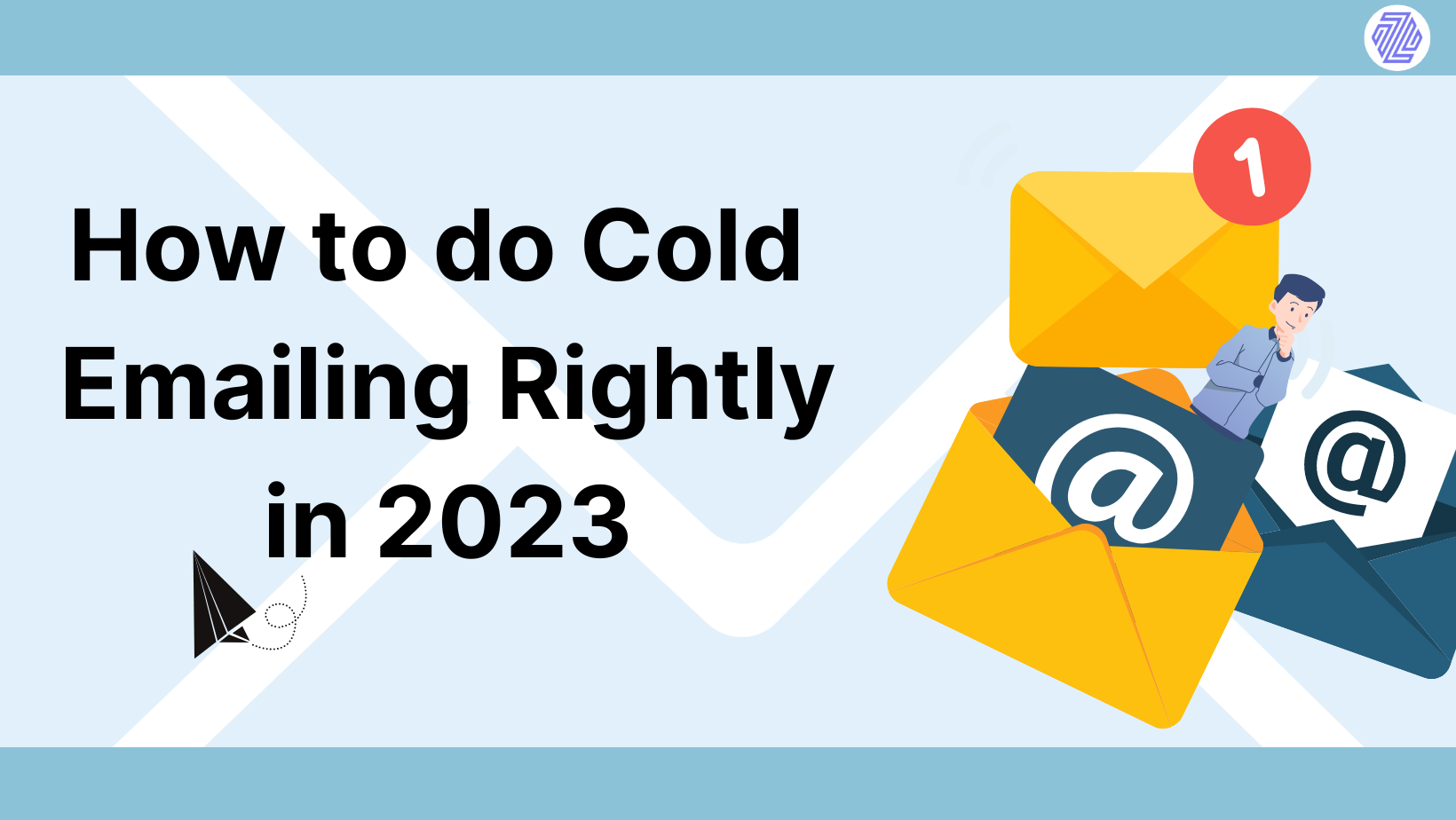First things first.
What is a Cold Email?
Cold emailing involves sending well-crafted emails to people you haven’t met yet. These emails introduce yourself, your business, or your ideas, and aim to start a conversation or explore potential opportunities for collaboration or connection. It’s a way to reach out to new contacts and build meaningful relationships.
You can refer to this guide for further introduction to cold emailing.
Differentiating Cold Emails from Warm and Hot Emails
Cold Emails:
-
Introduction: Cold emails are the first point of contact with someone who hasn’t interacted with you before.
-
Unfamiliarity: They are sent to recipients who may not know you or your business.
-
Objective: The primary goal is to initiate a connection and build awareness about your offering.
-
Minimal Precedence: Cold emails usually have no prior communication history or relationship.
-
Personalization: They require careful customization to grab the recipient’s attention and establish relevance.
-
Lower Response: Typically, response rates may be lower due to the initial lack of familiarity.
Warm Emails:
-
Established Contact: Warm emails are sent to individuals you’ve had some previous interaction or connection with.
-
Recognizable: The recipient is likely to recognize your name or affiliation, creating a sense of familiarity.
-
Intent: These emails focus on nurturing the existing relationship, sharing updates, or offering value.
-
Context: Conversations can refer back to prior exchanges, making communication smoother.
-
Moderate Response: Warm emails often receive better responses due to the established connection.
Hot Emails:
-
Urgency: Hot emails are driven by time-sensitive matters or immediate relevance.
-
High Relevance: They pertain to a current situation, offer, or event that the recipient is likely interested in.
-
Action-Oriented: These emails prompt quick responses, decisions, or actions from the recipient.
-
Peak Engagement: Hot emails often generate the highest response rates due to their urgency.
-
Short-Term Focus: The goal is to capitalize on the current opportunity or address an imminent need.
Now we get to the the Right Way to do Cold Emailing
Let’s break it down into steps
I. Researching and Building Your Prospect List
A. Identifying Your Target Audience
i. Define your ideal customer: Clearly outline the characteristics and traits of the individuals or businesses that would benefit most from your products or services.
You could read the blog on how to find your icp
ii. Segment your audience: Divide your target market into smaller groups based on shared demographics, interests, or needs.
iii. Example: If you’re a Graphic designing firm looking to design a certain SaaS tool, your audience would be SaaS based companies, in India or US or both.
B. Sourcing Relevant Contacts
i. Leverage your network: Tap into your existing connections, colleagues, friends, or acquaintances who might be able to introduce you to potential prospects.
ii. Attend events and conferences: Participate in industry gatherings or networking events to meet people who align with your target audience.
iii. Utilize social media: Search platforms like LinkedIn, Twitter, or industry-specific forums to find individuals who match your ideal customer profile.
iv. Example: If you’re a graphic designer, you might attend a design conference to connect with entrepreneurs in need of branding and design services.
C. Using Tools and Techniques for List Building
i. Business details finder tools: Employ tools that can extract contact information from websites or online directories (ensure legality and ethical use).
zScout helps find all business contact details of any company using just the company url.
ii. Lead generation software: Invest in software that helps you gather, organize, and manage contact information effectively. Softwares like Zintlr, Apollo.io or Lusha can help you with this.
Note : read the blog how Zintlr helps find your ICP
iii. Content marketing: Create valuable content like ebooks, webinars, or guides, that require email sign-ups to access the content.
You can check out the one Zintlr’s home page at the bottom
iii. Landing pages: Design dedicated landing pages with compelling offers to entice potential prospects to provide their contact details.
iv. Example: As a graphic designing tool, you could use a landing page offering a free guide on “10 Tips for capturing customer attention in first 5 seconds” to capture leads.
By combining these techniques, you’ll be able to assemble a high-quality prospect list filled with individuals who are genuinely interested in what you have to offer.
Next steps would be
II. Crafting Compelling Cold Emails
A. Subject Lines that Grab Attention
B. Personalization and Customization
C. The Importance of Value Proposition
D. Keeping Emails Clear and Concise
Here are some examples
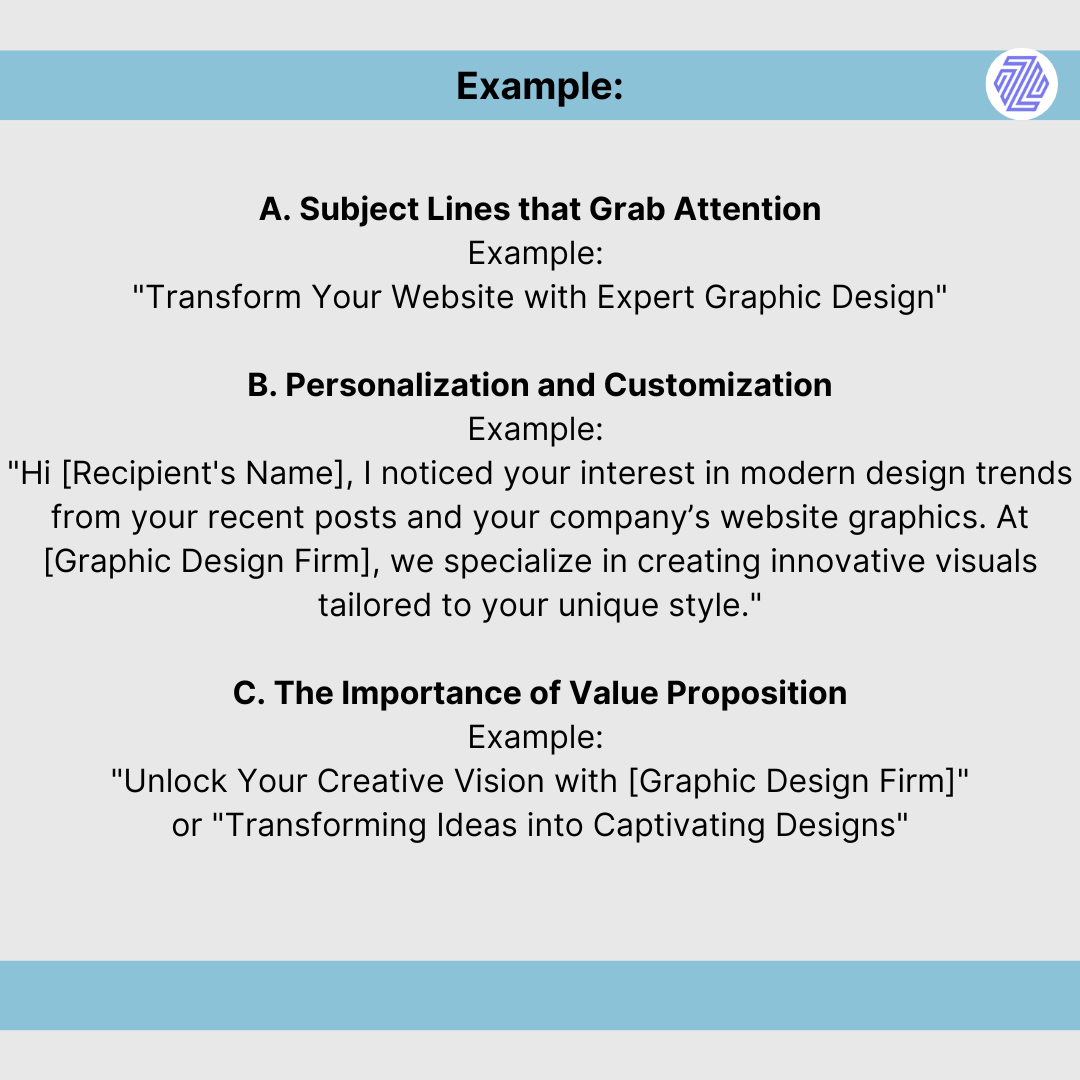
Example for keeping a concise email
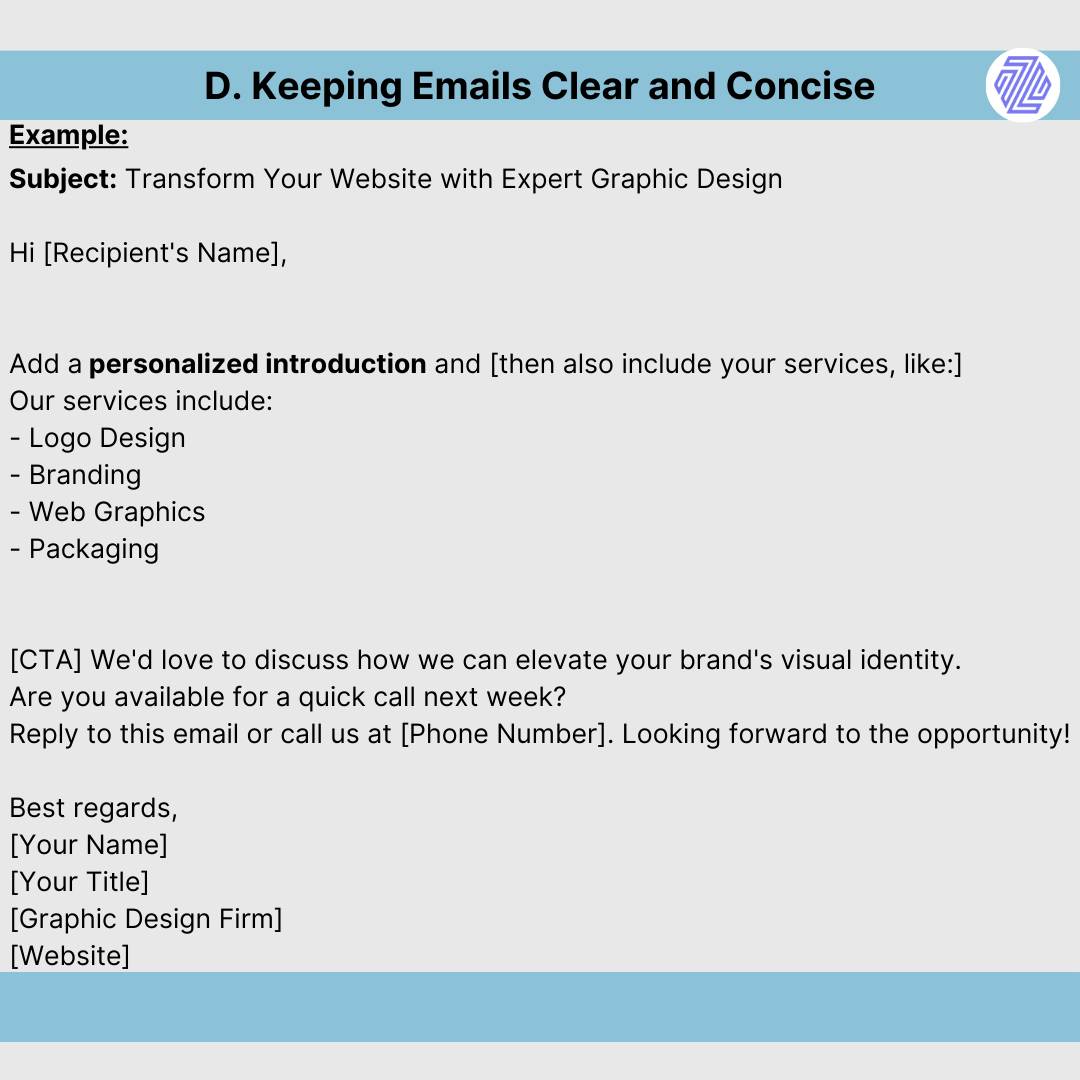
III. Writing an Effective Cold Email
A. Introduction and Establishing Credibility
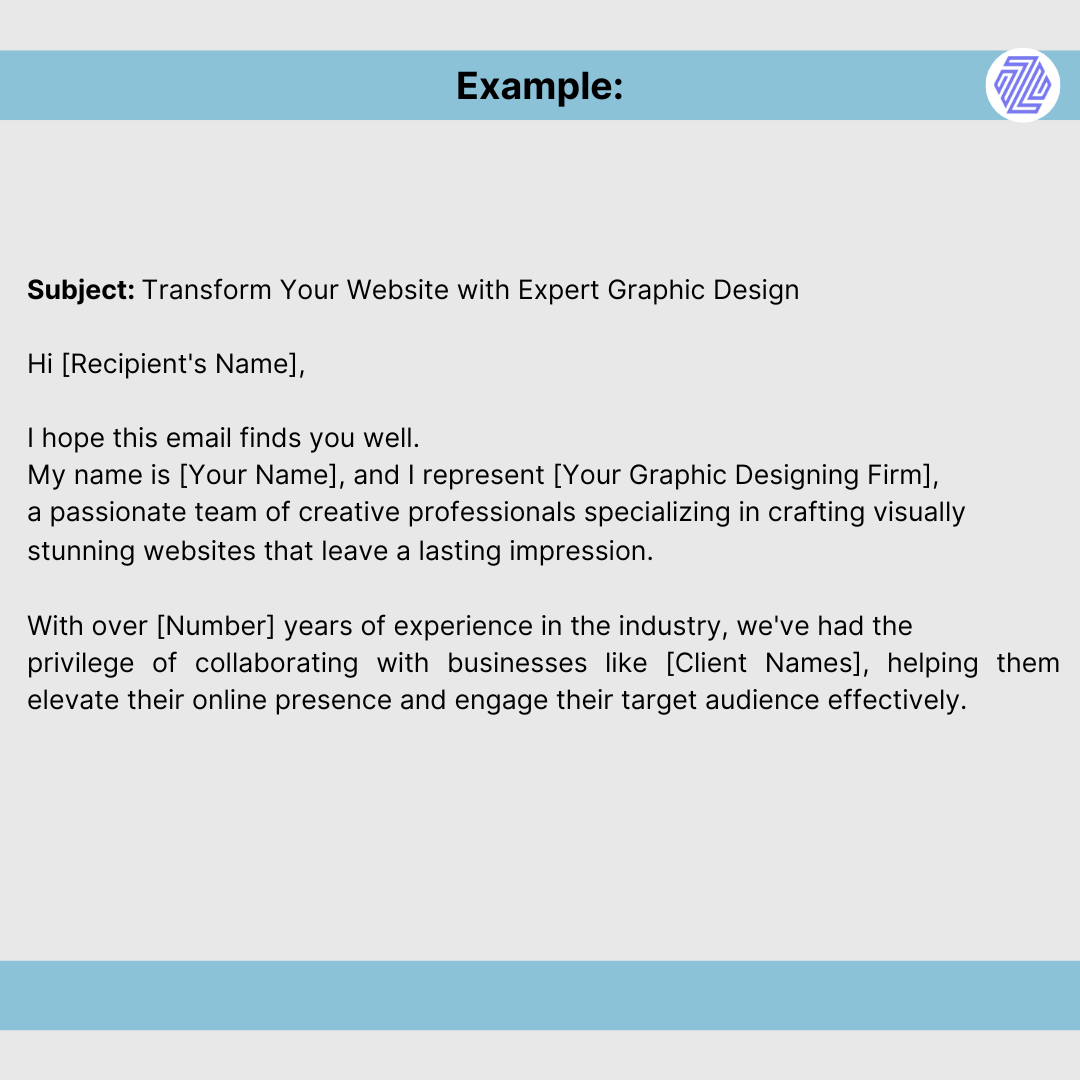
B. Making a Connection and Building Trust
Example:
We understand the challenges businesses face in today’s competitive digital landscape. Your commitment to [mention something specific about the recipient’s business or industry] truly resonated with us. We believe that a well-designed website is not just visually appealing, but also a strategic tool to drive growth and build trust with your customers.
C. Communicating the Purpose and Call-to-Action
Example:
Our goal is to help businesses like yours stand out with a website that not only reflects your brand’s uniqueness but also converts visitors into loyal customers.
Could we schedule a brief call to explore this matter a little more and learn from each other?
D. Closing with a Polite and Professional Tone
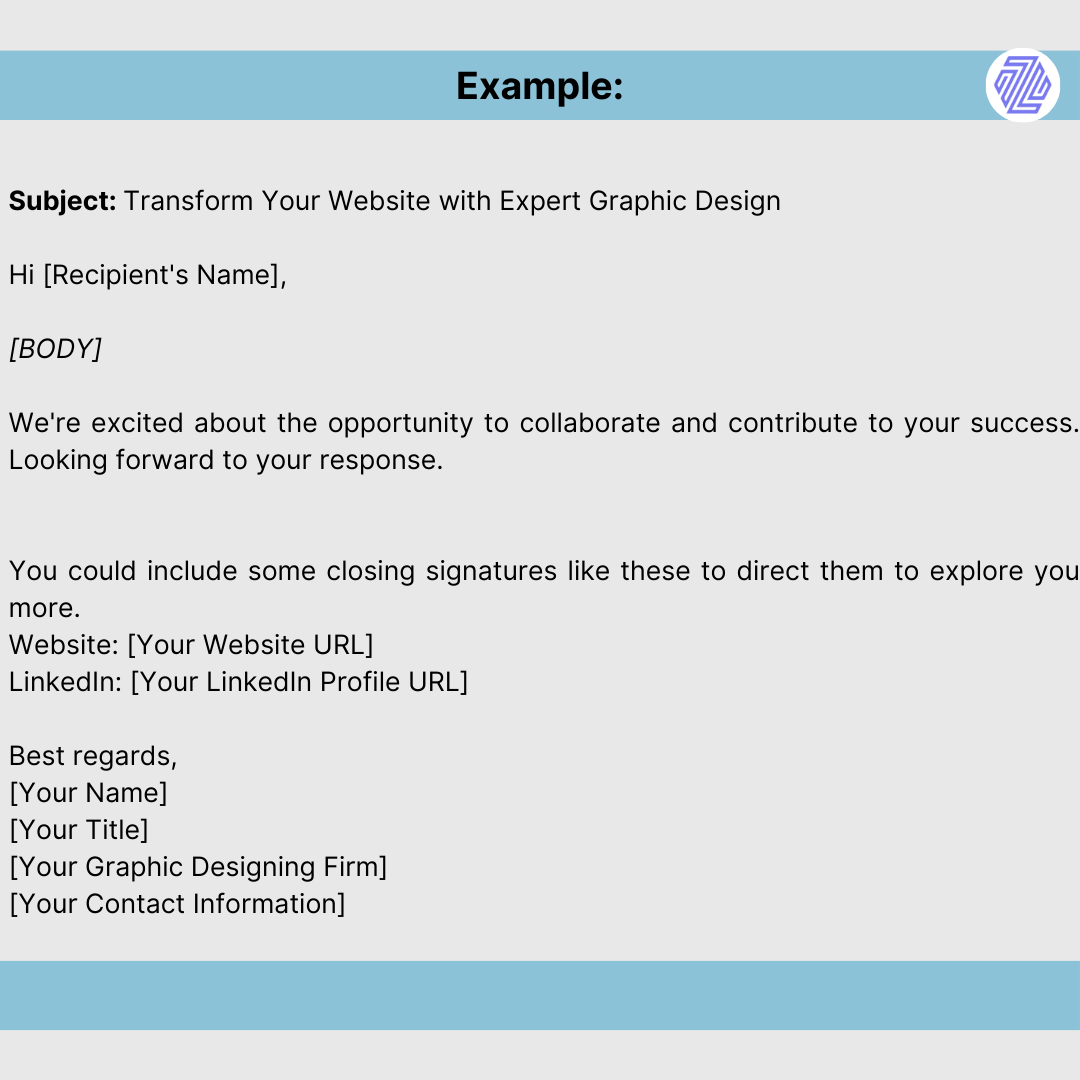
Note :
Keep the emails short and crisp (the above example are snippets you need to shorten them when put together)
And make sure not to sell openly, at least in the first email.
IV. Avoiding Common Mistakes in Cold Emailing
A. Overlooking Research and Personalization
When promoting your firm through cold emails, failing to conduct proper research and personalize your messages can undermine your efforts. Imagine sending a generic email to potential clients without understanding their specific design needs or preferences. This oversight can lead to your emails being dismissed as irrelevant or even spam.
Some people also keep a track of the personalised emails, if they know the value of them.
Like the author of this cold-email blog.
To avoid this mistake:
i. Research each recipient’s business or industry to understand their design requirements.
ii. Mention specific projects or design elements that align with their branding or style.
iii. Show that you’ve taken the time to learn about their company, making your email more compelling and relevant.
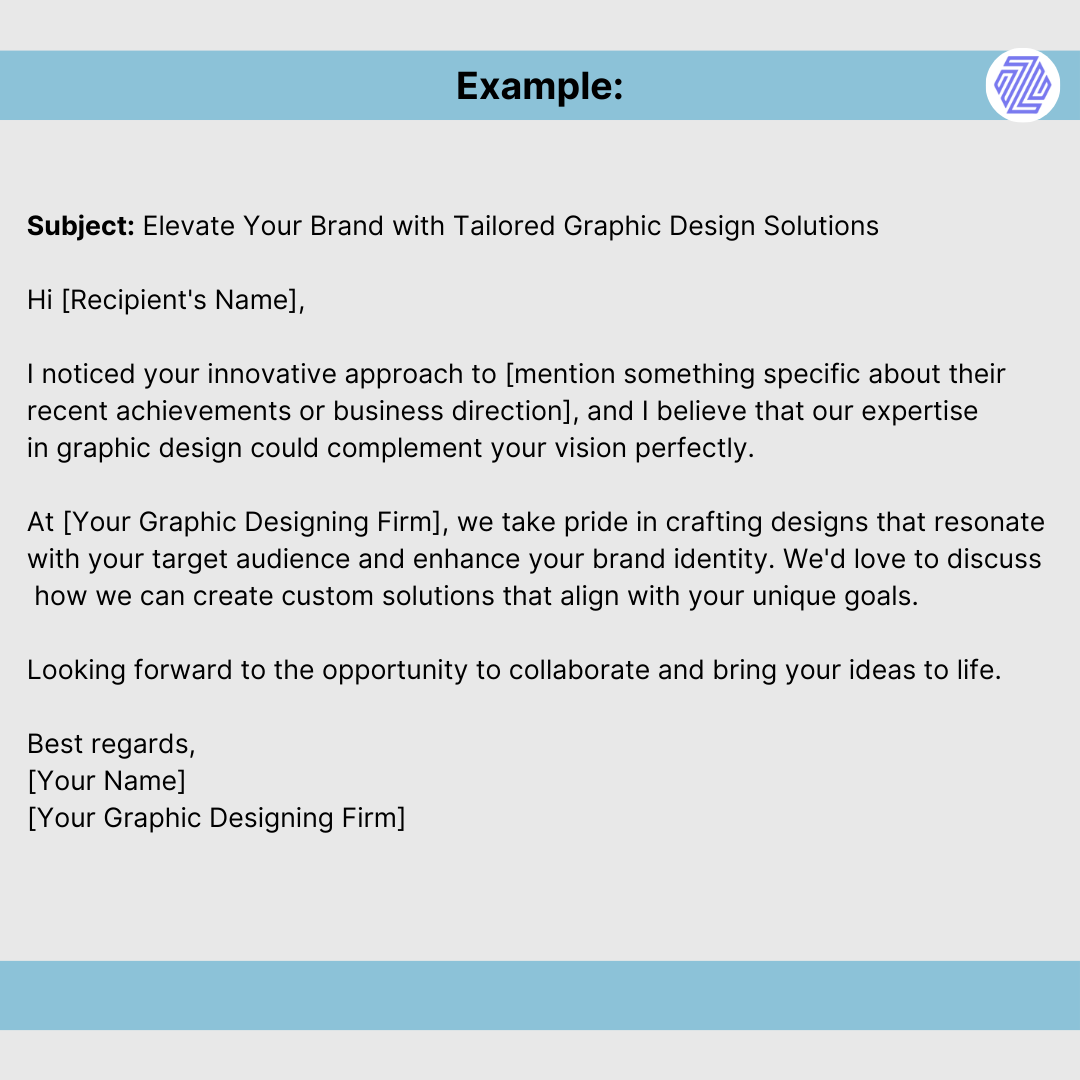
B. Using Spammy Language and Tactics
Using spammy language or tactics can tarnish your graphic designing firm’s reputation and cause your emails to be ignored or flagged as spam. Excessive use of exclamation marks, aggressive sales language, or misleading subject lines can create a negative impression and lead recipients to disregard your message.
To avoid this mistake:
i. Keep your language professional, respectful, and informative. ii. Avoid exaggerated claims and overly promotional content. iii. Craft subject lines that accurately represent the content of your email.
Read the article email deliverability: step-by-step guide to get the do’s and don’ts of sending an email and how to avoid landing in the spam box.
Here is a small example list of all spam words to avoid.
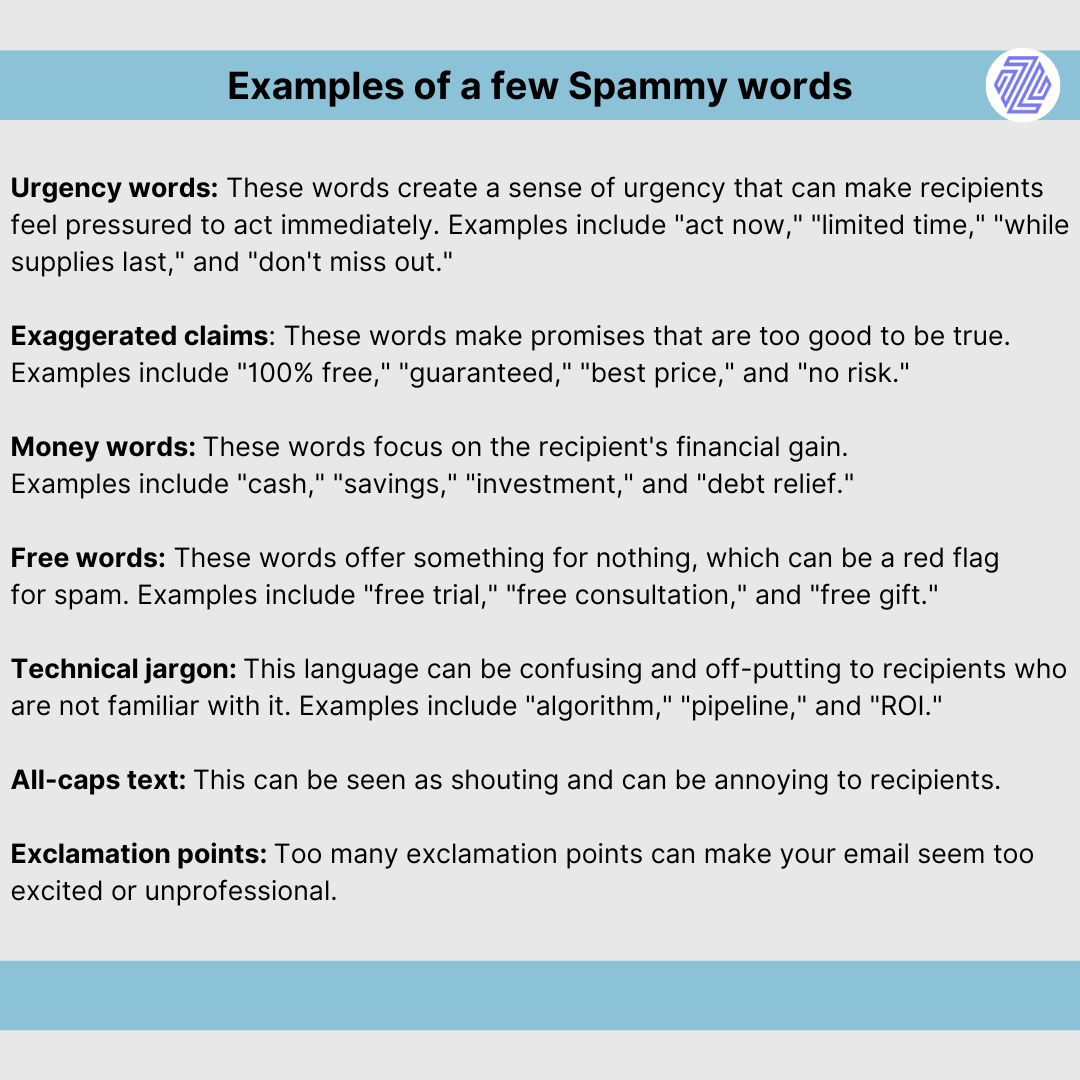
Example of what would be considered as a spam mail.
Subject: Enhance your Brand’s Aesthetics with thoughtful Graphic Design
Hi [Recipient’s Name],
We’ve been creating breathtaking designs that will revolutionize your brand’s online presence! Don’t miss out on this amazing opportunity! Act now and skyrocket your success!!!
Warm regards,
[Your Name]
[Your Graphic Designing Firm]
C. Neglecting Follow-ups and Persistence
Sending just one cold email and not following up can result in missed opportunities. Many recipients may not respond to the initial email, but that doesn’t mean they’re not interested. Neglecting to follow up could mean losing out on potential clients who simply got busy or overlooked your initial message.
To avoid this mistake:
i. Plan a well-spaced follow-up sequence (usually 2-3 follow-ups) to remind recipients of your initial email.
ii. Craft polite and non-intrusive follow-up messages that offer additional value or address potential concerns.
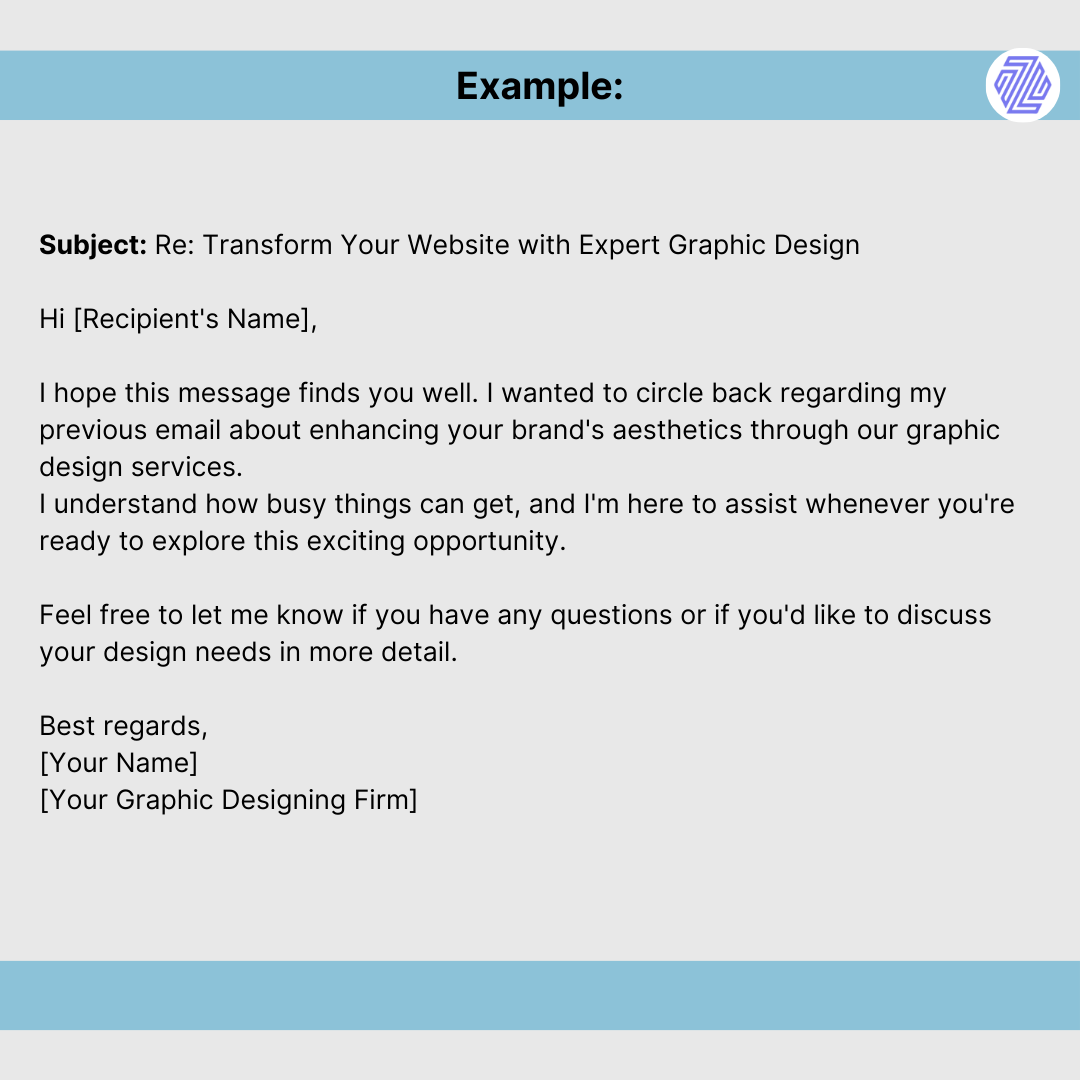
You could get a few other templates depending on scenarios from this article.
V. Strategies for Cold Emailing Success
A. A/B Testing Your Cold Email Campaigns
A/B testing, also known as split testing, is a powerful method for optimizing your cold email campaigns. By testing different elements of your emails, you can identify what resonates best with your recipients and refine your approach over time.
Example
i. Test different subject lines to see which one generates higher open rates.
ii. Experiment with variations in email copy, like emphasizing benefits or focusing on the firm’s experience.
B. Timing Your Emails for Maximum Impact
The timing of your cold emails can significantly affect their success. Sending emails when your recipients are most likely to check their inbox can increase the chances of engagement.
i. Consider sending emails early in the workweek, perhaps on Tuesday or Wednesday mornings when people are more likely to be responsive and planning their week.
ii. Avoid sending emails late on Friday or during weekends when they might get lost among other messages.
C. Leveraging Social Proof and Testimonials
Using social proof and testimonials in your cold emails can establish credibility and build trust with your recipients. Positive feedback from previous clients can encourage potential clients to consider your services. If you don’t have clients take up reviews from places you have launched or your social platforms feedback.
Showcase any awards or recognition your firm has received within your industry. (in this example the Design Industry)
The task doesn’t end here, after sending your emails there are a lot of other steps that need to be implemented like the ones below.
VI. Analyzing and Improving Your Cold Email Performance
This is very important to identify the progress and/or failures and to act upon them.
A. Tracking Metrics and Key Performance Indicators (KPIs)
B. Learning from Failures and Iterating Your Approach
C. Incorporating Feedback and Listening to Your Audience
VII. Overcoming Rejections and Handling Responses
You have to keep an open mind and expect that at least 20% responses might be negative and around 60-70% might be rejections.
But that doesn’t mean you stop trying. You must learn how to:
A. Deal with Negative Responses and Criticism
B. Turn Rejections into Opportunities
C. Respond Professionally to Positive Replies
Here’s a bonus section:
VII. Cold Emailing Best Practices
A. Building and Maintaining your Sender Reputation
Your sender reputation plays a crucial role in whether your emails reach recipients’ inboxes or get filtered as spam. Building and maintaining a positive sender reputation ensures that your cold emails have the best chance of being seen and engaged with.
Use a Recognizable Sender Name: Use a sender name that recipients can easily identify and associate with your brand or company. Avoid generic or ambiguous sender names.
Authenticate Your Domain: Set up email authentication protocols like SPF, DKIM, and DMARC to verify your domain and prevent spoofing or phishing attempts.
Monitor Bounce Rates: Regularly review bounce rates and clean your email list by removing invalid or outdated addresses. High bounce rates can negatively impact your sender reputation.
B. Complying with Email Regulations and Privacy Laws
Respecting email regulations and privacy laws is essential to maintain ethical and legal cold email practices.
Opt-In Consent: Only send cold emails to recipients who have given explicit permission or have a legitimate interest in receiving your emails. Avoid sending unsolicited messages.
Include an Unsubscribe Option: Provide a clear and easy way for recipients to unsubscribe from your emails. Honoring unsubscribe requests promptly is crucial to compliance.
Include Contact Information: Include your contact information in every email, making it easy for recipients to reach out or request more information.
C. Creating an Email Follow-up Sequence
A well-structured follow-up sequence enhances the chances of engaging recipients who may not have responded to your initial cold email.
Plan Follow-up Timing: Determine a strategic timeline for follow-ups, sending them at intervals that are not overly intrusive but still maintain engagement.
Provide Value: Each follow-up should offer additional value, such as sharing relevant content or addressing common pain points your recipients might have.
Adjust Messaging: Customize your follow-up messages based on recipient interactions. If they opened your initial email but didn’t respond, your follow-up could express interest in their thoughts.
D. Knowing when to Stop and Respect Boundaries
Respecting recipient boundaries is crucial for maintaining a positive reputation and avoiding annoyance.
Limit Follow-ups: After a certain number of follow-ups without response, it’s essential to recognize when to stop. Persisting beyond a reasonable point may lead to negative perceptions.
Respect Opt-Out Requests: Honor unsubscribe requests immediately and ensure the recipient’s information is removed from your mailing list promptly.
Avoid Aggressive Language: Use polite and respectful language in all communications. Pushy or aggressive tactics can lead to negative perceptions and harm your reputation.
That brings us to an end of this article.
Feel free to reach out to me on LinkedIn for any queries or assistance.
Until then Happy Networking!

